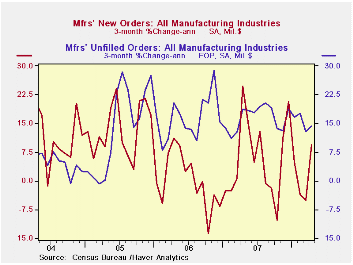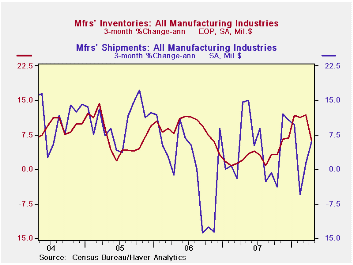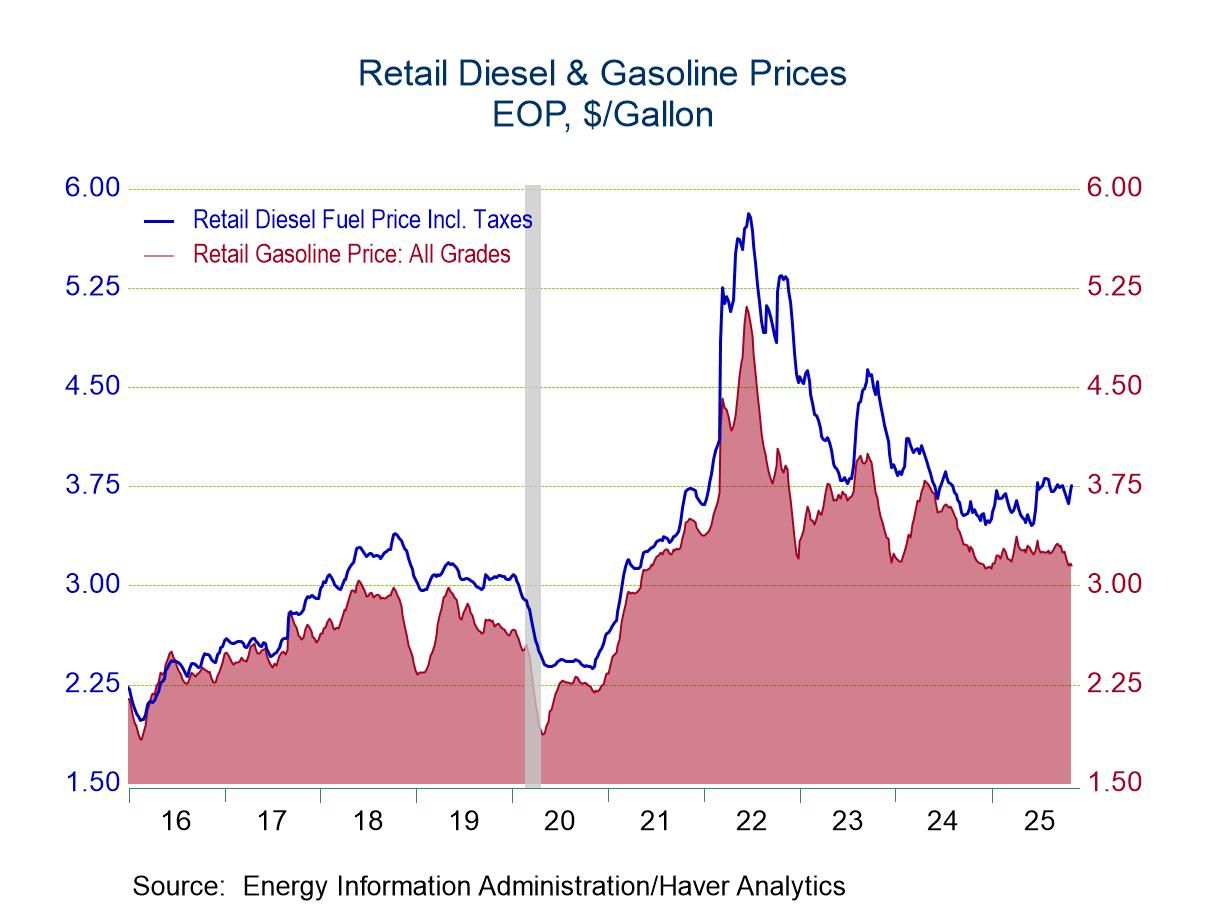 Global| Jun 03 2008
Global| Jun 03 2008U.S. Factory Inventories Slipped in April
by:Tom Moeller
|in:Economy in Brief
Summary
Factory inventories slipped slightly during April after increases near 1.0% during the prior several months. The three-month growth rate, as a result, eased to 6.2% which was half the recent rates of growth. Inventories of nondefense [...]

Factory inventories slipped slightly during April after increases near 1.0% during the prior several months. The three-month growth rate, as a result, eased to 6.2% which was half the recent rates of growth.
Inventories of nondefense aircraft and light trucks posted strong increases over the last three months of 14.1% and 31.1%, respectively. Automobile inventories, conversely, are down at a 47.7% rate. Less the transportation sector altogether inventories fell 0.2% in April and three-month growth totaled 4.6%.
Inventory accumulation in the machinery sector was firm at 9.0% over the last three months after a 5.4% 2007 increase while the rate of accumulation in the computer area surged to 10.7% after slight decumulation last year. Working the other way, nondurable inventories fell 1.0% during April and three-month growth eased to 2.8% after double digit growth rates earlier this year. Petroleum inventories fell 6.4% in April and that pulled three-month negative after double digit growth last year.
Factory shipments surged 2.2% during April, double the March jump. Higher prices lifted shipments of petroleum by 6.3% after a 10.7% March jump. Less petroleum shipments still surged by 1.6% following declines during the prior several months. Shipments of textiles and apparel have been falling hard but machinery shipments rose at an 8.7% rate during the last three months. Computer shipments and of electrical equipment & appliances also have fallen.
Total factory orders rose another firm 1.1% although that reflected the 6.3% jump in petroleum orders (which equal shipments). Less petroleum, shipments rose 0.4% and three- month growth picked up to 2.8%. Durable orders overall fell 0.6% which was little different than reported in the advance report.
Overall unfilled orders rose 0.9% in April and the three-month growth rate remained firm at 14.4%. Much of that strength has been due to higher backlogs of civilian aircraft which have been rising at a 28.3% rate. Excluding the transportation sector altogether unfilled orders still rose 1.5% in April. Accelerated growth in backlogs of machinery and electrical equipment accounts for that strength.
| Factory Survey (NAICS, %) | April | March | Y/Y | 2007 | 2006 | 2005 |
|---|---|---|---|---|---|---|
| Inventories | -0.0 | 0.9 | 6.0 | 3.7 | 6.4 | 8.9 |
| Excluding Transportation | -0.2 | 0.8 | 5.0 | 2.7 | 7.9 | 8.1 |
| New Orders | 1.1 | 1.5 | 3.8 | 1.9 | 6.2 | 11.9 |
| Excluding Transportation | 2.6 | 2.6 | 7.9 | 1.2 | 7.4 | 11.7 |
| Shipments | 2.2 | 1.1 | 5.0 | 1.2 | 5.9 | 10.4 |
| Excluding Transportation | 2.3 | 1.9 | 6.7 | 1.5 | 6.7 | 11.4 |
| Unfilled Orders | 0.9 | 1.3 | 16.0 | 17.1 | 15.3 | 15.4 |
| Excluding Transportation | 1.5 | 0.8 | 9.0 | 8.2 | 16.0 | 9.2 |
Tom Moeller
AuthorMore in Author Profile »Prior to joining Haver Analytics in 2000, Mr. Moeller worked as the Economist at Chancellor Capital Management from 1985 to 1999. There, he developed comprehensive economic forecasts and interpreted economic data for equity and fixed income portfolio managers. Also at Chancellor, Mr. Moeller worked as an equity analyst and was responsible for researching and rating companies in the economically sensitive automobile and housing industries for investment in Chancellor’s equity portfolio. Prior to joining Chancellor, Mr. Moeller was an Economist at Citibank from 1979 to 1984. He also analyzed pricing behavior in the metals industry for the Council on Wage and Price Stability in Washington, D.C. In 1999, Mr. Moeller received the award for most accurate forecast from the Forecasters' Club of New York. From 1990 to 1992 he was President of the New York Association for Business Economists. Mr. Moeller earned an M.B.A. in Finance from Fordham University, where he graduated in 1987. He holds a Bachelor of Arts in Economics from George Washington University.






